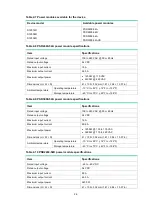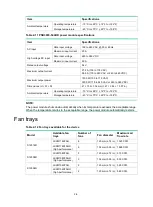
4-2
RJ-45
Signal
DB-9
Signal
7
DSR
4
DTR
8
CTS
7
RTS
Ethernet twisted pair cable
An Ethernet twisted pair cable consists of four pairs of insulated wires twisted together. It mainly
transmits analog signals and is advantageous in transmitting data over shorter distances. The
maximum transmission distance is 100 m (328.08 ft).
RJ-45 connector
An Ethernet twisted pair cable connects network devices through the RJ-45 connectors at the two
ends.
shows the pinouts of an RJ-45 connector.
Figure 4-2 RJ-45 connector pinout diagram
Cable pinouts
EIA/TIA cabling specifications define two standards: 568A and 568B for cable pinouts.
•
Standard 568A
—pin 1: white/green stripe, pin 2: green solid, pin 3: white/orange stripe, pin 4:
blue solid, pin 5: white/blue stripe, pin 6: orange solid, pin 7: white/brown stripe, pin 8: brown
solid.
•
Standard 568B
—pin 1: white/orange stripe, pin 2: orange solid, pin 3: white/green stripe, pin 4:
blue solid, pin 5: white/blue stripe, pin 6: green solid, pin 7: white/brown stripe, pin 8: brown
solid.
Cable type
Based on performance
Ethernet cables can be classified as category 3, category 4, category 5, category 5e, category 6,
category 6A, and category 7 cables based on performance. Category 5, category 5e, and category 6
are the most commonly used twisted pair cables on LANs.
Table 4-2 Ethernet cable description
Type
Description
Category 5
Transmits data at a maximum speed of 100 Mbps, with a bandwidth of 100 MHz.
Category 5e
Transmits data at a maximum speed of 1000 Mbps, with a bandwidth of 100 MHz.
PIN #8
PIN #1








































